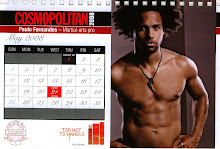Embora pareça brincadeira e a maior parte das pessoas leve alguns instantes a entender o sentido da resposta, é verdade: se quiser ter abdominais mais fortes, deve comer menos (“empurrar a mesa”, em sentido figurado) e treinar mais, em vez de fazer somente exercícios de abdominais.
Várias pesquisas já foram feitas e resposta tem sido sempre
a mesma: não é possível diminuir gordura especificamente numa área, exercitando
apenas essa área. Isto significa que quem faz abdominais para poder “perder
barriga” ou quem vai ao ginásio exercitar-se na máquina de abdutores / adutores
está, muito possivelmente, a perder tempo. Exercitar o corpo inteiro é, e
sempre será, a chave principal para perder gordura.
Quer ter melhor definição abdominal? Em vez de
fazer abdominais extra, termine todos os seus treinos com “high intensity
interval training” (treino intervalado, conforme é conhecido pelos
especialistas de fitness), que consiste num treino de circuito com uma maior
elevação da frequência cardíaca e menos tempo possível de descanso.
HIIT é a chave para a perda de peso e definição
muscular, pois queima mais calorias do que um treino aerobio.
Num HIIT, uma vez o treino é
feito com uma intensidade cardíaca acima de 65%, pode perder entre 7 a 9
calorias por minuto, enquanto num treino com intensidade cardíaca abaixo de 60%
perderá apenas entre 3 a 5 calorias por minuto.
Fazer
abdominais irá provocar-lhe dores nas costas muito antes de conseguir ver resultados a nível de definição. O
ideal é treinarmos o nosso CORE, ou seja, fazermos exercícios que trabalham ao
mesmo tempo os ombros, tronco, abdominais e ancas.
Um
bom programa de CORE é muito mais do que fazer abdominais. A maior parte do
treino de CORE consiste em exercícios isométricos, tais como fazer a “prancha”
(também conhecido por “ponte”) ou atirar a bola medicinal com toda a força para
o chão ou parede.
Obter
um CORE forte é a chave para a prevenção de dores de costas, ajudando-o também
a melhorar a sua performance (desempenho) no desporto que pratica.
Conclusão: Os abdominais são os grandes estabilizadores do tronco. Mas, para os
fortalecer, é preferível fazer exercícios que trabalham a estabilidade do
tronco e não exercícios de flexão e extensão.
Paulo
Fernandes
Sport management & Fitness Diploma
Certified Strength and Conditioning Specialist (CSCS)https://www.facebook.com/TotalBodyActivity
Sport management & Fitness Diploma
Certified Strength and Conditioning Specialist (CSCS)https://www.facebook.com/TotalBodyActivity




















No comments:
Post a Comment